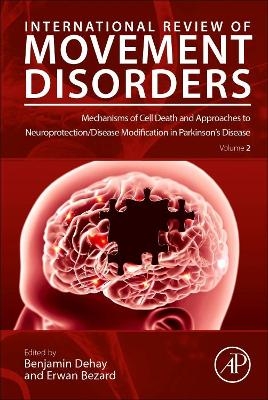
Mechanisms of Cell Death and Approaches to Neuroprotection/Disease Modification in Parkinson’s Disease
Academic Press Inc (Verlag)
978-0-323-89943-7 (ISBN)
Along with degeneration, the pathological hallmark of PD is the presence of intraneuronal proteinaceous cytoplasmic inclusions, named Lewy Bodies (LB) that invade the whole nervous system as the disease progresses. Several fundamental discoveries have shed light upon the implication of the a-syn protein in the pathogenesis of familial and sporadic forms of PD. Other proteins also accumulate in LB, but a-syn is a major protein component of the pathological landmarks.
INSERM Research Associate, obtained his PhD from the University of Paris VI in 2007, under the supervision of Dr. Bertolotti, in the context of Huntington’s disease. He was then trained as a postdoctoral researcher at the laboratory of Dr. Vila in Barcelona, where his work mainly focused on the molecular mechanisms of neuronal cell death and the mechanism and significance of Lewy body formation in Parkinson’s disease. Since 2010, he has been working in the Institute of Neurodegenerative Diseases Research Group of Dr. Bezard, first as a senior postdoctoral fellow, where he subsequently obtained an Independent Investigator position as an INSERM Research Associate in 2013. Dr. Dehay’s scientific career has been focused to understand how the disease proteins cause alterations of the autophagy-lysosomal pathway, contributing to the pathogenesis for then proposing adapted therapeutic approaches to clear the toxic proteins and halt the disease process. He has a broad expertise in the field and in molecular and cell biology approaches and pathophysiological investigations in animal models including non-human primates, rodent models and on human tissues. Finally, some of the scientific highlights include the study of the progressive spreading of synucleinopathy through disease modeling across species. INSERM Research Director, has authored or co-authored over 300 professional publications in the field of neurobiology, most of which are on Parkinson's disease and related disorders. Listed among of the most cited neuroscientists, he is known for his work on the compensatory mechanisms that mask the progression Parkinson's disease, the pathophysiology of levodopa-induced dyskinesia, the intimate mechanisms of cell death in Parkinson’s disease, the modelling of disease progression and the development of new strategies to alleviate symptoms and/or to slow disease progression. Bezard has funded in 2010, and headed until 2020, a CNRS research unit located in Bordeaux, the Institute of Neurodegenerative Diseases, which features preclinical and clinical researchers working towards development of therapeutic solutions. He is also a Visiting Professor at the China Academy of Medical Sciences (Beijing, China) where he has set-up and manages a non-human primate facility dedicated to Movement Disorders.
1. Alpha-synuclein spreading mechanisms in Parkinson’s disease: The role of membrane receptors
Inês C. Brás and Tiago F. Outeiro
2. Modeling synucleinopathies in rodents
Anna Barber Janer, Eline Vonck and Veerle Baekelandt
3. Spreading of alpha-synuclein pathology from the gut to the brain in Parkinson's disease
Benjamin Jevans and Donato A. Di Monte
4. PINK1: Multiple mechanisms of neuroprotection
Britney N. Lizama, P. Anthony Otero and Charleen T. Chu
5. Mechanisms of VPS35-mediated neurodegeneration in Parkinson's disease
Dorian Sargent and Darren J. Moore
6. Mechanisms of cell death and approaches to neuroprotection/disease modification in Parkinson’s disease
Alexis Martinez, Maria Jesus Cerna, Romina Gozalvo and Claudio Hetz
7. Immune response during idiopathic Parkinson's disease: From humans to animal models
Sara Konstantin Nissen, Sara A. Ferreira, Ida Klæstrup and Marina Romero-Ramos
| Erscheinungsdatum | 02.11.2021 |
|---|---|
| Reihe/Serie | International Review of Movement Disorders |
| Verlagsort | Oxford |
| Sprache | englisch |
| Maße | 152 x 229 mm |
| Gewicht | 390 g |
| Themenwelt | Medizin / Pharmazie ► Medizinische Fachgebiete ► Neurologie |
| Technik ► Elektrotechnik / Energietechnik | |
| ISBN-10 | 0-323-89943-9 / 0323899439 |
| ISBN-13 | 978-0-323-89943-7 / 9780323899437 |
| Zustand | Neuware |
| Haben Sie eine Frage zum Produkt? |
aus dem Bereich


